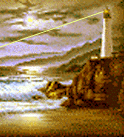

The Fifty Miracle Principles
of A Course in Miracles
by Kenneth Wapnick
Principle 37
A miracle is a correction introduced
into false thinking by me.
It acts as a catalyst, breaking
up erroneous perception and reorganizing it properly.
This places you under the Atonement
principle, where perception is healed.
Until this has occurred, knowledge
of the Divine Order is impossible.
"Erroneous perception" is perceiving a problem in the world, external to us. The miracle reorganizes perception because it shifts perception back to where the problem really is, in our minds. Jesus is the one who introduces the miracle. Our job is merely to choose to want him to, to ask his help to see the situation the way he does. This is true perception. Jesus takes the false perceptions we have made real -- sickness, conflict, war, etc.-- and turns them around so that we see everything the same way: everyone, including ourselves, is calling for help. The Atonement principle is then chosen, which can be restated as the denial of the reality of the separation and guilt.
Another technical term used consistently throughout A Course in Miracles is "knowledge." As the Course uses it, it is synonymous with Heaven. The counterpart to knowledge, or the opposite to knowledge, is perception, and almost always you will see those two terms juxtaposed. Knowledge transcends the subject-object dichotomy, which is inherent in perception. Even "holy visions" (such as those many mystics report) are perceptual and, therefore, do not last.
Knowledge is of spirit, of God, and cannot be attained in this world. In fact, the Course says very clearly that knowledge is not the goal of this Course; peace is (text, p. 128; T-8.I.1:1-2). Here it is talking about the peace that comes within this world when you look on all people as being joined with you. There is no guilt and no attack.
Click here to return to Index